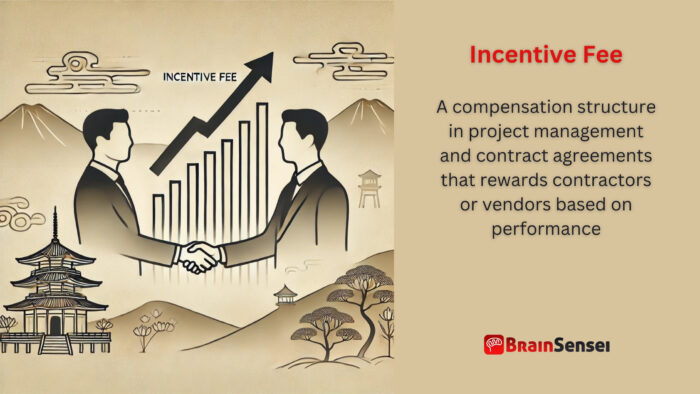
Incentive Fee
What is an Incentive Fee?
An incentive fee is a compensation structure in project management and contract agreements that rewards contractors or vendors based on performance. Project managers use incentive fees to encourage efficiency, cost savings, timely completion, or high-quality deliverables beyond the basic contractual requirements. These fees are commonly found in cost-plus-incentive-fee (CPIF) or fixed-price-incentive-firm (FPIF) contracts, where the buyer links the supplier’s compensation to specific performance metrics.
Key Takeaways
- Incentive fees reward contractors for exceeding performance targets related to cost, schedule, or quality.
- Organizations typically use them in cost-reimbursement or fixed-price contracts with adjustable elements.
- The contract must clearly define the incentive structure to align contractor goals with project objectives.
- Effective in government, construction, IT, and large-scale infrastructure projects.
- It may include positive incentives (bonuses) or negative incentives (penalties for underperformance).
Understanding Incentive Fees
How Incentive Fees Work
Incentive fees operate on a predefined formula where contractors earn additional compensation for meeting or exceeding specific project goals. These goals can include:
- Completing the project ahead of schedule
- Staying under the budget
- Achieving superior quality or innovation
- Enhancing safety or sustainability measures
Contracts with incentive fees typically specify a target cost or performance threshold, a sharing ratio (splitting cost savings or overruns between the contractor and client), and a maximum/minimum fee cap to limit excessive bonuses or penalties.
Key Considerations
- The incentive structure must be measurable to ensure fairness and transparency.
- Misaligned incentives can lead to unintended consequences, such as cutting corners to meet cost goals.
- Requires robust contract management and oversight to ensure compliance.
- Often used in high-risk or uncertain projects where fixed pricing is impractical.
Related Terms
- Fixed-Price Incentive-Firm (FPIF) Contract: This contract adjusts the seller’s profit based on performance and sets a ceiling price.
- Cost-Plus-Incentive-Fee (CPIF) Contract: This is a cost-reimbursement contract where the fee is adjusted based on performance efficiency.
- Award Fee: A subjective incentive fee determined by client evaluation rather than a fixed formula.
- Performance-Based Contracting (PBC): A contract structure focusing on results rather than processes, often including incentives.
- Risk-Reward Sharing: A contractual arrangement where the client and vendor share in cost savings or overruns.
Examples of Incentive Fees in Different Industries
Construction Industry
A government agency contracts a construction firm to expand a significant highway to ease traffic congestion. The contract, designed to minimize commuter disruptions and keep the project on track, incentivizes early completion. The incentive structure specifies that if the contractor completes the project 30 days before schedule, they will receive an additional $2 million bonus. However, if the project exceeds the agreed timeline, the contractor will pay a penalty of $100,000 per day of delay.
Motivated by the potential bonus, the contractor optimizes resource allocation, deploys additional crews for night shifts, and leverages prefabrication techniques to accelerate construction. However, they must also balance speed with quality and safety to ensure compliance with government standards. They implement regular inspections and third-party oversight to prevent cost-cutting that could compromise structural integrity.
In this case, the incentive fee structure effectively aligns the contractor’s financial interests with the government’s goal of minimizing road closures. As a result, the project finished 25 days early, earning the contractor a $1.5 million bonus. Additionally, the early completion reduces indirect costs, such as traffic detours and fuel consumption for commuters, benefiting the broader community.
This example highlights how incentive fees in construction projects drive efficiency, accelerate timelines and create a win-win scenario for both the contractor and the client. However, it also underscores the importance of contract clarity, as vague performance metrics or unrealistic timelines can lead to disputes.
IT & Software Development
A financial services firm hires a technology company to develop a custom banking software system that enhances fraud detection and transaction security. Given the highly competitive industry and the need for rapid deployment, the client includes an incentive fee structure linked to milestone deliveries and software stability.
The contract specifies that for every sprint completed ahead of schedule, the software vendor receives a 10% bonus on that milestone’s cost. Additionally, the firm offers a quality incentive fee, where the vendor earns an extra $500,000 if system defects remain below 0.5% post-launch.
The vendor adopts an Agile development approach to maximize earnings, ensuring iterative testing and early bug detection. The team accelerates deployments by leveraging automated testing tools and DevOps pipelines while maintaining high software quality. The vendor collaborates closely with the client’s in-house IT team to gather feedback, reducing the risk of last-minute design changes.
Despite some unforeseen challenges, including a third-party API integration issue, the vendor delivered three out of four milestones ahead of schedule, earning a $750,000 incentive bonus. Furthermore, maintaining a defect rate of only 0.4%, they secured an additional $500,000 quality bonus.
This case demonstrates how incentive fees in IT contracts encourage vendors to prioritize speed and quality. By structuring bonuses around measurable outcomes, companies can drive innovation while reducing project risks. However, project managers must manage scope creep and unrealistic timelines through effective contract governance, as potential pitfalls remain.
Aerospace & Defense
The military awards a defence contractor a project to develop a new fighter jet prototype. Given the high costs and technical complexities, the government agency selects a cost-plus-incentive-fee (CPIF) structure. Under this structure, the government agency reimburses the contractor for actual costs and awards an incentive fee based on performance.
The contract sets a target cost of $500 million, with a 10% incentive fee if the contractor meets or reduces costs while maintaining performance benchmarks. A fuel efficiency bonus offers $50 million in incentives if the aircraft achieves at least 15% better fuel efficiency than existing models.
To optimize costs and maximize incentive earnings, the contractor invests in lightweight composite materials, advanced aerodynamics, and AI-driven fuel optimization algorithms. However, balancing cost efficiency with stringent military safety and performance requirements presents challenges. Unforeseen supply chain disruptions and material shortages threaten cost control, requiring adaptive strategies.
Through effective project management, cost control measures, and technological innovation, the contractor delivered the prototype for $480 million, securing an additional $20 million in incentive fees. Additionally, the aircraft exceeded fuel efficiency expectations, earning the full $50 million bonus.
This case highlights the effectiveness of incentive fees in aerospace and defence projects, encouraging cost efficiency and innovation while maintaining quality. However, it also underscores the risks of over-promising performance metrics, as failing to meet targets can strain contractor-client relationships.
Key Takeaways from the Examples
- Well-structured incentive fees drive efficiency, cost savings, and quality improvements across industries.
- Clear performance metrics and transparent contract terms are crucial to avoiding disputes.
- Balancing incentives and penalties ensures that contractors remain motivated without cutting corners.
- Flexibility in high-risk projects (e.g., aerospace and software development) allows for adaptive incentive structures to accommodate evolving challenges.
- Monitoring mechanisms such as third-party audits, milestone tracking, and regular evaluations ensure incentive alignment with project objectives.
By strategically using incentive fee structures, organizations can achieve superior project outcomes while maintaining strong vendor relationships and ensuring accountability.
Use Cases of Incentive Fees in Different Regions
North America (Public Infrastructure Projects)
In the United States, incentive fees are commonly used in public infrastructure projects to ensure timely and cost-efficient execution. The government often employs fixed-price incentive contracts (FPIF) to motivate contractors to complete work ahead of schedule while maintaining strict safety and quality standards.
For instance, the Boston Big Dig, a large-scale highway tunnel construction project, incorporated incentive fees to encourage efficiency. While the project faced budget overruns due to unforeseen geological conditions, early completion incentives helped mitigate delays and motivated contractors to deliver high-quality work under tight deadlines.
Europe (Renewable Energy Initiatives)
European countries are using incentive fees to fund renewable energy projects. For example, a wind farm developer in Germany earns an output-based incentive fee and receives additional payments when energy production exceeds the agreed-upon megawatt capacity over five years. This approach encourages the adoption of higher-efficiency turbines and innovative energy storage solutions to maximize output.
Similarly, in the UK, the government offers feed-in tariffs with performance incentives to solar energy providers, ensuring that green energy contributions to the grid remain stable and cost-efficient. This approach promotes sustainability and fosters technological advancements in renewable energy storage and grid integration.
Asia (Smart City Development)
Asian cities, particularly in technologically advanced countries like Singapore and South Korea, are incorporating incentive-based contracts into smart city infrastructure projects. For example, a Singaporean technology firm developing an AI-powered traffic management system earns an additional incentive fee if urban congestion rates decrease by at least 20% within the first year of deployment. This technique ensures that vendors remain committed to achieving tangible outcomes that align with city planning objectives.
Japan applies similar incentives to automated waste management systems in major metropolitan areas. Contractors earn bonuses for reducing landfill waste through efficient recycling and AI-driven waste sorting. These bonuses incentivize innovation, and contractors achieve long-term efficiency improvements in waste reduction strategies.
Key Insights from Use Cases
- Incentive fees in government projects help mitigate delays and improve cost efficiency.
- Energy and sustainability initiatives benefit from performance-based incentives to drive innovation.
- Innovative city projects leverage incentive contracts to ensure technology-driven solutions achieve measurable improvements.
- Clear contractual guidelines are essential to prevent disputes and ensure successful incentive alignment.
Implementing well-structured incentive fee models can enhance efficiency, drive innovation, and ensure successful project outcomes for organizations in various sectors.
Best Practices for Implementing Incentive Fees
To maximize the benefits of incentive fees, organizations should follow these best practices:
Define Clear Performance Metrics
A common challenge with incentive fees is ensuring that performance targets are clearly defined. Ambiguous criteria can lead to disputes between clients and contractors. Instead, organizations should establish measurable and achievable goals. For instance, defining success based on specific cost savings, efficiency rates, or on-time completion percentages ensures clarity for both parties.
Balance Risk and Reward
A well-structured incentive fee should balance both upside and downside risks. If the incentive is too high, it may lead to cost-cutting at the expense of quality. On the other hand, if it is too low, it may not sufficiently motivate the contractor. Those structuring incentive fees ensure contractors are rewarded by setting reasonable caps and floors without introducing perverse incentives.
Regular Monitoring and Adjustments
Organizations should not adopt a “set it and forget it” approach to incentive fees. Instead, they should conduct regular performance reviews to assess whether the incentive structure effectively motivates desired behaviours. The team should adjust mid-project to address unforeseen challenges or evolving business needs if necessary.
Avoid Unintended Consequences
While incentive fees can be powerful motivators, poorly designed structures can lead to unintended consequences. For example, if a contractor is rewarded solely for completing a project early, they may compromise safety or quality. A well-balanced contract should include incentives for meeting multiple objectives, such as cost savings, speed, and quality.
Legal and Contractual Clarity
Organizations should clearly state the incentive fee’s structure, the performance measurement methods, and the dispute resolution mechanisms within their contracts. Clear contractual language prevents conflicts and ensures that all parties have a mutual understanding of expectations.
Align Incentives with Organizational Goals
The incentive structure should align with the organization’s broader strategic goals. If an organization prioritizes sustainability, the incentive should encourage energy efficiency, reduced waste, or lower emissions rather than just cost savings.
Incorporate Third-Party Audits
Third-party auditors can verify the fulfillment of incentive conditions to ensure transparency and fairness. They are critical in high-stakes projects, such as government infrastructure or large-scale defence contracts, where multiple stakeholders participate.
Encourage Collaboration Instead of Competition
Incentive fees should be structured to encourage cooperation among teams rather than fostering an overly competitive environment that may lead to conflict. Contracts should include mechanisms for shared incentives, ensuring all contributors are equally motivated to achieve project goals.
Consider Long-Term Impact Over Short-Term Gains
While incentive fees often focus on short-term performance, organizations should also assess long-term impacts. Rushing the completion of a construction project might lead to higher maintenance costs later. A well-designed incentive structure considers total lifecycle value rather than just immediate outcomes.
Adapt to Project Complexity and Industry Standards
Different industries require different approaches to incentive fees. A one-size-fits-all approach does not work. For example:
- Construction companies may base incentives on safety, timeline, and material efficiency.
- In IT, incentives revolve around code quality, bug resolution speed, and user adoption rates.
- In defence, meeting cost efficiency and performance benchmarks is often the primary focus. Understanding each industry’s unique challenges requires tailoring the incentive fee model appropriately.
Case Study: Incentive Fees in Practice
A global logistics company implemented an incentive fee structure in its supply chain operations. They introduced bonuses for suppliers who reduced transportation costs without increasing delivery times. Over one year, participating vendors improved delivery efficiency by 18%, leading to a 10% reduction in logistics costs. The company reinvested these savings into supply chain innovation, demonstrating how well-structured incentives can create continuous improvement cycles.
Final Thoughts
Incentive fees can be a powerful tool for achieving project success, encouraging innovation, and aligning contractor goals with organizational objectives. However, they require careful planning, clear metrics, and continuous oversight to be effective. By applying these best practices, organizations can ensure that their incentive structures drive desired outcomes and foster healthy, productive working relationships with all stakeholders.
Common Mistakes and Issues in Incentive Fee Structures
While incentive fees can drive efficiency and performance, poorly designed structures can lead to unintended consequences. Below are some common mistakes challenges encountered when implementing incentive fees, and mitigation strategies.
Poorly Defined Performance Metrics
One of the most frequent issues with incentive fees is the lack of clear, measurable performance criteria. If targets are vague or subjective, disputes may arise over whether the contractor has met the agreed-upon goals. For example, a contract stating “improve efficiency” leaves room for interpretation. Instead, the contract should define specific metrics such as cost reduction percentages, project completion dates, and quality scores.
Solution:
- Clearly define what constitutes successful performance in quantifiable terms.
- Use SMART goals (Specific, Measurable, Achievable, Relevant, and Time-bound) to ensure clarity.
- Establish a third-party review process to verify target completion objectively.
Unbalanced Risk and Reward Structure
A poorly structured incentive fee model may place excessive risk on one party while disproportionately benefiting the other. If a contractor perceives that the potential reward does not justify the associated risk, they may lack motivation to meet the incentive goals. Conversely, if the incentive is too lucrative, it may lead to unethical shortcuts to maximize earnings.
Solution:
- Structure incentives with a balanced risk-reward ratio.
- Set a maximum cap on incentives to prevent runaway costs.
- Include penalties for low-quality outcomes or unethical behaviour.
Encouraging Short-Term Gains Over Long-Term Value
A common pitfall of incentive fee structures is that they prioritize short-term results at the expense of long-term sustainability. For instance, in a construction project, a contractor may use lower-quality materials to speed up completion and earn a bonus, leading to higher maintenance costs in the future.
Solution:
- Design incentive structures that reward long-term quality and performance.
- Implement post-project evaluations to ensure durability and functionality.
- Consider multi-tiered incentives, such as bonuses for sustained performance over time.
Lack of Transparency and Accountability
Another frequent issue is the difficulty in verifying performance data. If contractors self-report metrics without oversight, there is a risk of inflated claims or manipulated data to secure higher bonuses.
Solution:
- Third-party audits and independent verification of performance data are required.
- Use automated tracking systems (e.g., time-stamped progress reports) to provide real-time visibility.
- Implement a dispute resolution mechanism in the contract to handle disagreements reasonably.
Overly Complex Incentive Structures
Sometimes, incentive fee models are too complicated, making them difficult to understand and implement effectively. If contractors and clients struggle to interpret the conditions, misunderstandings and disputes may occur.
Solution:
- Keep the incentive structure simple and easy to understand.
- Use precise language in contracts, avoiding excessive legal or technical jargon.
- Provide stakeholder training sessions to ensure a common understanding of the incentive mechanisms.
Misalignment with Organizational Objectives
Incentive structures must align with an organization’s core objectives and values. Employees and contractors may neglect environmental considerations to maximize financial rewards if a company values sustainability but only incentivizes cost-cutting.
Solution:
- Ensure that incentive fees reflect the overall strategic priorities of the organization.
- Introduce multi-factor incentive models considering sustainability, customer satisfaction, innovation, and financial efficiency.
Failure to Adapt to Changing Conditions
External factors such as market fluctuations, supply chain disruptions, or regulatory changes can impact a project’s feasibility. If an incentive structure does not allow adjustments, it may become impractical or ineffective.
Solution:
- Incorporate flexibility clauses in the contract to allow for reasonable adjustments.
- Conduct periodic performance reviews to reassess incentive structures and update them as needed.
- Use a collaborative approach, engaging all stakeholders in discussions about necessary changes.
Final Thoughts
While incentive fees can be a powerful tool for driving performance, they require careful design and ongoing oversight to avoid unintended consequences. Organizations should focus on clear, measurable goals, maintain fair risk-reward structures, and ensure long-term sustainability over short-term financial gains.
By proactively addressing these common mistakes, companies can create practical and fair incentive structures that drive meaningful improvements while maintaining ethical and transparent business practices.
Incentive Fee: Frequently Asked Questions (FAQs)
How is an incentive fee different from an award fee?
An incentive fee is based on a predefined formula, whereas an award fee is discretionary and determined by the client’s subjective performance evaluation.
Can incentive fees be applied to small-scale projects?
Yes, but they are more effective in large, complex projects where performance variations significantly impact cost, schedule, or quality.
Are incentive fees standard in government contracts?
Yes, especially in military, infrastructure, and technology projects where performance incentives drive efficiency and cost savings.
What industries benefit most from incentive fees?
Construction, aerospace, defence, IT, and energy sectors frequently use incentive fees to align contractor objectives with project goals.
How do clients ensure incentive fees lead to positive outcomes?
To ensure incentive fees lead to positive outcomes, clients establish clear, measurable performance targets and conduct regular project oversight to prevent quality trade-offs or ethical violations.
Additional Resources
- Cost-plus-incentive fee (CPIF)
- What is Cost Plus Incentive Fee Contract (CPIF) in Project Management?
Preparing for a PMI certification?
- Exam Prep Courses: PMP®, CAPM®, and PMI-ACP®
- Exam Simulators: PMP®, CAPM®, PMI-ACP®, PMI-PBA®, PMI-RMP®, PMI-SP®, PgMP®, and PfMP®
- Professional Development Units (PDUs): 15, 30, and 60 PDU Bundles



